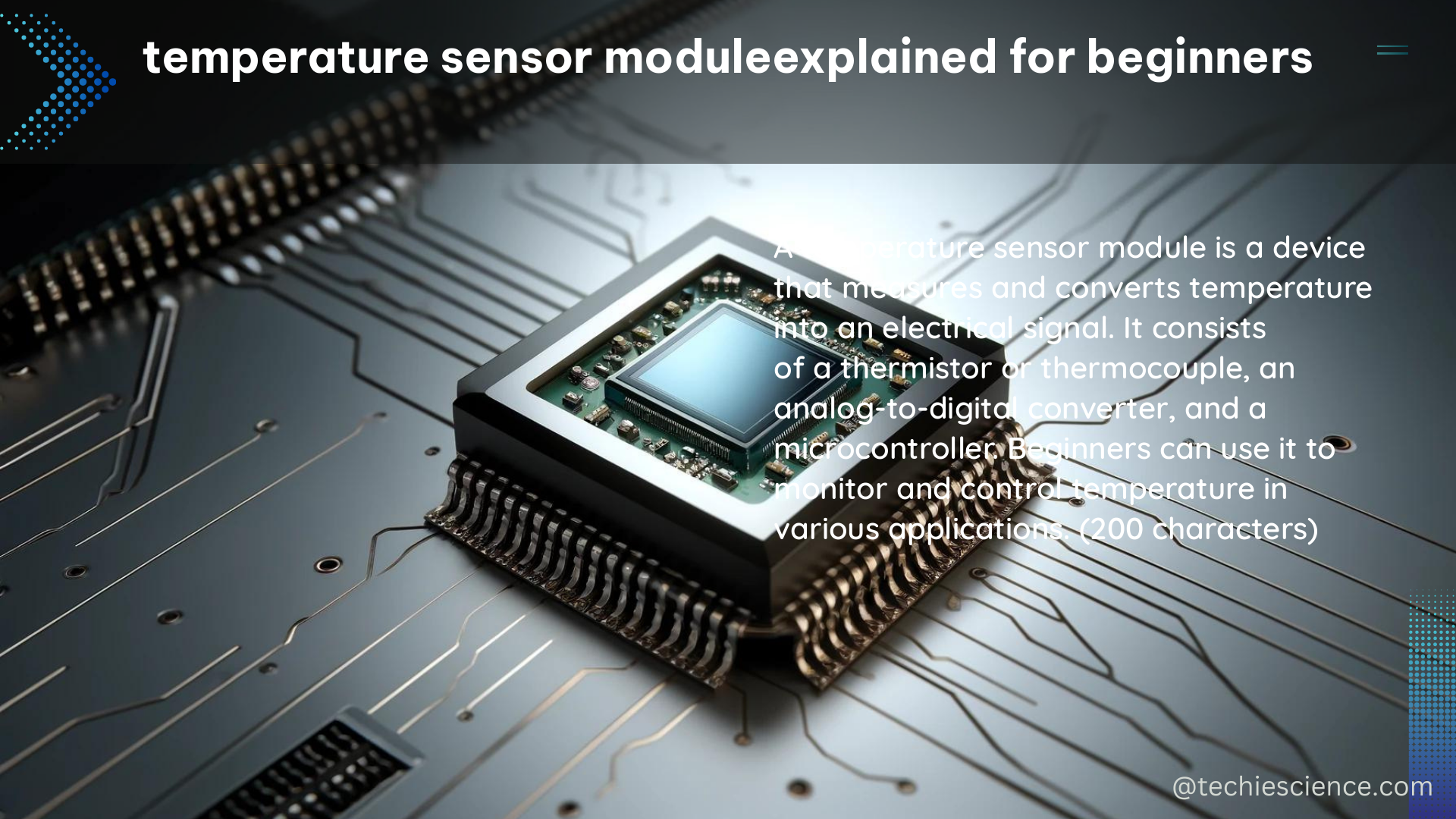Temperature sensor modules are essential devices used to measure the temperature of an environment or object. These modules convert the physical temperature into a digital signal that can be read and interpreted by a microcontroller or computer. Understanding the different types of temperature sensors, their features, and how to select the right one for your application is crucial for any beginner in the field of electronics and automation.
Types of Temperature Sensors
There are several types of temperature sensors available, each with its own unique characteristics and applications. The most common types include:
-
Thermocouples: Thermocouples are made of two dissimilar metal wires that generate a small voltage when exposed to a temperature difference. They are known for their wide temperature range, ruggedness, and high-temperature capabilities, making them suitable for industrial applications.
-
Resistance Temperature Detectors (RTDs): RTDs are sensors that use the change in electrical resistance of a metal (typically platinum) to measure temperature. They offer high accuracy, stability, and repeatability, making them popular in precision applications.
-
Thermistors: Thermistors are temperature-sensitive resistors that exhibit a large, predictable, and repeatable change in electrical resistance with temperature. They are known for their high sensitivity, fast response time, and low cost, making them suitable for consumer electronics and home appliances.
-
Integrated Circuit (IC) Temperature Sensors: IC temperature sensors, such as the popular DS18B20 and DHT22, integrate the temperature sensing element and signal conditioning circuitry into a single package. These sensors offer digital output, making them easy to interface with microcontrollers and other digital systems.
DS18B20 Temperature Sensor

The DS18B20 is a widely used integrated circuit temperature sensor that communicates over a 1-Wire interface, requiring only one port pin for communication. Some key features of the DS18B20 include:
- Temperature Range: -55°C to +125°C
- Accuracy: ±0.5°C from -10°C to +85°C
- Resolution: 9 to 12 bits (configurable)
- Unique 64-bit Serial Code: Allows multiple sensors to be used on the same data bus
- Power Supply: 3.0V to 5.5V
- Low Power: Parasitic power mode allows operation without a power supply
The DS18B20 is commonly used in thermostatic controls, industrial systems, consumer products, thermometers, and any thermally sensitive system that requires accurate temperature measurement.
DHT22 Temperature and Humidity Sensor
The DHT22 is a popular sensor that can measure both temperature and humidity. Some key features of the DHT22 include:
- Temperature Range: -40°C to +80°C
- Humidity Range: 0% to 100% RH
- Accuracy: ±0.5°C for temperature, ±2% for humidity
- Resolution: 0.1°C for temperature, 0.1% for humidity
- Power Supply: 3.3V to 5V
- Single-Wire Interface: Requires only one port pin for communication
The DHT22 is commonly used in weather stations, HVAC systems, and environmental monitoring applications where both temperature and humidity data are required.
Selecting the Right Temperature Sensor
When selecting a temperature sensor for your application, there are several factors to consider:
-
Temperature Range: Ensure that the sensor’s temperature range covers the expected operating conditions of your system.
-
Accuracy: Determine the required level of precision for your application and choose a sensor with an appropriate accuracy specification.
-
Communication Interface: Select a sensor with a communication interface that is compatible with your microcontroller or computer, such as 1-Wire, I2C, or SPI.
-
Power Requirements: Consider the power supply requirements of the sensor and ensure that it is compatible with your system’s power source.
-
Physical Dimensions: Ensure that the sensor’s physical size and mounting options are suitable for your application.
-
Cost: Evaluate the cost of the sensor and its associated components, such as breakout boards or development kits, to fit within your project’s budget.
By understanding the different types of temperature sensors, their features, and the factors to consider when selecting one, you can make an informed decision and choose the best temperature sensor module for your beginner-level project.
Additional Resources
Here are some additional resources that can help you further explore temperature sensor modules:
- DS18B20 Temperature Sensor Datasheet
- DHT22 Temperature and Humidity Sensor Datasheet
- Temperature Sensor Comparison: Thermocouples, RTDs, and Thermistors
- Understanding Temperature Sensor Accuracy and Precision
- Interfacing Temperature Sensors with Microcontrollers
Remember, the key to success in working with temperature sensor modules is to understand the underlying principles, experiment with different sensors, and continuously learn from your experiences. Happy tinkering!
References:
- How to Read and Interpret Digital Temperature Sensor Output Data. (n.d.). Retrieved from https://www.ti.com/lit/an/sbaa588/sbaa588.pdf?ts=1713166373337
- DS18B20 Temperature Sensor Tutorial – YouTube. (2016, April 7). Retrieved from https://www.youtube.com/watch?v=qxEclOy6jpI
- How to use DHT22 Sensor to Measure Temperature and Humidity. (2023, May 24). Retrieved from https://www.youtube.com/watch?v=GNCh0soyLg8
- The Complete Guide to Temperature Sensors – SolisPLC. (n.d.). Retrieved from https://www.solisplc.com/tutorials/temperature-sensors

The lambdageeks.com Core SME Team is a group of experienced subject matter experts from diverse scientific and technical fields including Physics, Chemistry, Technology,Electronics & Electrical Engineering, Automotive, Mechanical Engineering. Our team collaborates to create high-quality, well-researched articles on a wide range of science and technology topics for the lambdageeks.com website.
All Our Senior SME are having more than 7 Years of experience in the respective fields . They are either Working Industry Professionals or assocaited With different Universities. Refer Our Authors Page to get to know About our Core SMEs.